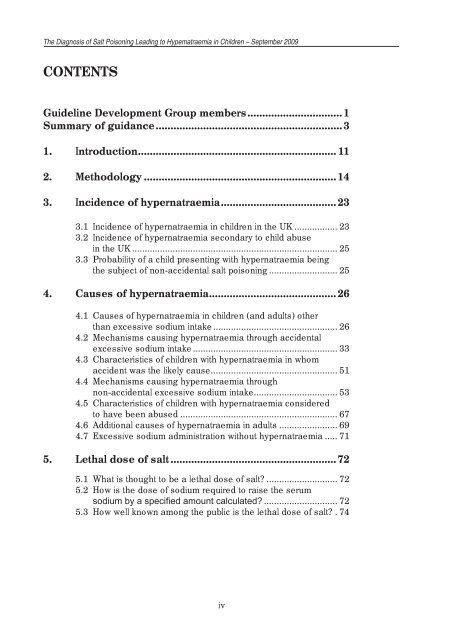The differential diagnosis of hypernatraemia in children, with ...
The differential diagnosis of hypernatraemia in children, with ...
The differential diagnosis of hypernatraemia in children, with ...
You also want an ePaper? Increase the reach of your titles
YUMPU automatically turns print PDFs into web optimized ePapers that Google loves.
<strong>The</strong> Diagnosis <strong>of</strong> Salt Poison<strong>in</strong>g Lead<strong>in</strong>g to Hypematraemia <strong>in</strong> Children – September 2009<br />
CONTENTS<br />
Guidel<strong>in</strong>e Development Group members................................ 1<br />
Summary <strong>of</strong> guidance...............................................................3<br />
1. Introduction................................................................... 11<br />
2. Methodology..................................................................14<br />
3. Incidence <strong>of</strong> <strong>hypernatraemia</strong>....................................... 23<br />
3.1 Incidence <strong>of</strong> <strong>hypernatraemia</strong> <strong>in</strong> <strong>children</strong> <strong>in</strong> the UK.................. 23<br />
3.2 Incidence <strong>of</strong> <strong>hypernatraemia</strong> secondary to child abuse<br />
<strong>in</strong> the UK.................................................................................. 25<br />
3.3 Probability <strong>of</strong> a child present<strong>in</strong>g <strong>with</strong> <strong>hypernatraemia</strong> be<strong>in</strong>g<br />
the subject <strong>of</strong> non-accidental salt poison<strong>in</strong>g............................ 25<br />
4. Causes <strong>of</strong> <strong>hypernatraemia</strong>........................................... 26<br />
4.1 Causes <strong>of</strong> <strong>hypernatraemia</strong> <strong>in</strong> <strong>children</strong> (and adults) other<br />
than excessive sodium <strong>in</strong>take.................................................. 26<br />
4.2 Mechanisms caus<strong>in</strong>g <strong>hypernatraemia</strong> through accidental<br />
excessive sodium <strong>in</strong>take.......................................................... 33<br />
4.3 Characteristics <strong>of</strong> <strong>children</strong> <strong>with</strong> <strong>hypernatraemia</strong> <strong>in</strong> whom<br />
accident was the likely cause.................................................. 51<br />
4.4 Mechanisms caus<strong>in</strong>g <strong>hypernatraemia</strong> through<br />
non-accidental excessive sodium <strong>in</strong>take................................. 53<br />
4.5 Characteristics <strong>of</strong> <strong>children</strong> <strong>with</strong> <strong>hypernatraemia</strong> considered<br />
to have been abused............................................................... 67<br />
4.6 Additional causes <strong>of</strong> <strong>hypernatraemia</strong> <strong>in</strong> adults........................ 69<br />
4.7 Excessive sodium adm<strong>in</strong>istration <strong>with</strong>out <strong>hypernatraemia</strong>...... 71<br />
5. Lethal dose <strong>of</strong> salt.........................................................72<br />
5.1 What is thought to be a lethal dose <strong>of</strong> salt?............................. 72<br />
5.2 How is the dose <strong>of</strong> sodium required to raise the serum<br />
sodium by a specified amount calculated?.............................. 72<br />
5.3 How well known among the public is the lethal dose <strong>of</strong> salt?.. 74<br />
iv

















